PECO
My own preferred R-T-R chassis; smooth running with unobtrusive
wheelsets and wagons are correct scale distance apart thanks to the Peco
couplers. The Peco chassis are available separately however some compromises
have been made to some of the bodies used in order to standardise on these
chassis. There are a total of six chassis types; steel framed nine foot
wheelbase, steel and wooden underframed ten foot wheelbase wagons, ten and
fifteen foot wheelbase brake vans and a fifteen foot wheelbase steel wagon. The
pre nationalisation liveries are all of the pre 1937 large letter type, where
any actual inaccuracies have been noted corrected forms appear in the text.
Chassis details
Peco offer a nine foot wheelbase chassis but only in kit form, this
represents the standard RCH chassis used from the late nineteenth century. It
is XXX mm OH, XXX mm WB and XXX mm OA. The axle boxes are of the `Gloucester'
type, used by the GWR, SR and most private owners.
XXX To confirm dimensions of new Peco chassis - Kit in spares box
The 10 foot wheelbase wagon chassis is available separately and
consists of a single moulding with sockets for the Peco Else coupling and
standard Peco wheelsets which just clip in place. It represents the RCH
standard 17 foot 6 inches over headstocks design. It is available with either
steel or wooden solebars, although all RTR models are supplied on the steel
chassis. Both types of ten foot wheelbase wagon chassis and the ten foot
wheelbase brake van chassis are all 36 mm OH, 21 mm WB and 45 mm OA. The axle
boxes are of the `Gloucester' type, used by the GWR, SR and most private
owners.
The 15 foot steel wagon chassis is a relatively modern design, dating
from the 1960's and originally used for PO wagons, such as oil tanks, and also
for the Grano leased grain hopper. The axle boxes are of the LMS/BR type. It is
53mm OH, 31.5mm WB and 62 mm OA. The 15 foot wheelbase brake van chassis is a
steel solebar chassis. It is 53 mm OH, 32 mm WB and 62 mm OA.
Note that the ends of the 15 foot chassis extend a scale 5 feet beyond
the outer end of the suspension, the ends of the 10 foot chassis extend about
three feet. Some 10 foot wheel base vehicles had a standard brake gear
but a longer body than the standard, if you cut off the ends of a 10 foot
chassis, level with the outer end of the suspension, then similarly cut off the
ends of the 15 foot chassis the two longer ends and the chassis can then be
mated. I have used this trick to produce various longer then normal wagons,
unfortunately the ten foot chassis ends cannot be re-used as the cut falls
across the coupling pocket although this does give you the parts to add buffers
to American RTR wagons.
The brake van chassis are often preferable for kit-bashing, these have
no brake detail other than the clasp shoes on the longer version and inner
single shoes on the ten foot chassis. This makes adding brake lever detail
easier, if you can live with the inaccuracies however the standard chassis can
be used.
For convenience I have divided the stock into that based on the nine, ten
and fifteen foot wheelbase chassis (although there are no ready to run models on the nine foot wheelbase chassis).
Models on the 9 foot wheelbase chassis
These models are currently only available in kit form, they have a frame on the base of the floor to allow accurate
alignment of the solebars and headstocks so even a complete beginner has a
better than even chance of getting the thing to roll well. The kits also
include a new variation on the standard Peco coupler with a separate retaining
cup to be glued to the chassis.
7 plank Open Wagon
A useful mineral wagon suitable for layouts set from the pre-grouping era into the early 1970s.
BR 16 ton Steel Mineral Wagon
The sixteen tonner end-door wagons were the single most common type on
BR up to the late 1960's, the last of the unfitted vehicles disappeared from
the revenue earning fleet in the early 1970's, a few of the vacuum fitted
examples (never very common) soldiered on into the early 1980's.
BR 27 ton Iron Ore Tippler Wagon
The twenty seven ton tippler wagons are simply door-less versions of the
mineral wagon. These were introduced in 1951 for iron ore but used for a wide
range of cargo including stone, chalk and sand.
BR 20 ton Pig Iron Wagon
This wagon is essentially a half-heigh version of the ore tippler. Widely used for sand traffic.
Models on the 10 foot wheelbase chassis
SINGLE BOLSTER PAIR - I was not able to identify a specific
prototype for this model however it does capture the correct general appearance
of the type. Note that most of these designs used a shorter wheel base, often 8
foot, however BR did convert some 10 foot wheel base wagons to single bolsters.
Details of how to shorten these models have been included in the section on Kit
Bashing.
CONFLAT - This is a late (1943) GWR design, subsequently produced
by BR, the lettering on the wagon is BR in all cases. To make it a GWR design
add a tiebar between the bottom of the axle boxes and the letters G & W on
the solebar to either side of the chain pockets (the central board on the
chassis side). The containers should be secured to the wagon, this can be done
using simple `turnbuckles' made from plastic rod or wire, for details of
securing methods see the section on container design.
The container supplied by Peco is the furniture container (Type BK)
dating from 1933, which is identical with the bicycle container (Type BC) also
dating from the 1930's. A more common type of container was the General purpose
type BD, which had double doors on each side as well as the end door. Parkwood Models offer a kit of one A type and one BD type container, however the Peco container can be modified by either replacing the
sides or sanding them down and re-scribing them. I have made a pair of A type containers from a cut-in-half Peco container, but this did require a fair bit of re-scribing and new strapping added from 10x20 thou strip. As I did not wish to bother producing a convincing door-end on I added a tarpaulin conver for a 'leaky roof' to one of the containers.
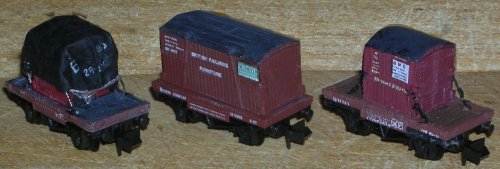
These older wooden containers
were all phased out of service by the late 1970's. The container liveries
supplied for the GWR date from 1934, and for the LMS variant the livery dates
from 1932. The BR livery is early BR. The LNER used a deep blue livery with
white lettering for furniture containers and the SR used their passenger livery
of sea green and yellow lettering.
In about 1935 there was a degree of standardisation on lettering between
the Big Four companies and the LNER adopted a roundel type logo, similar to the
GWR `shirt button' on their furniture containers. Some of these wagons were
modified for the Speedlink container service but with the change to the ISO
container most of the remaining vehicles were fitted with bolsters and
close-coupled in pairs. The chain pockets remained in place so all you need do
is add the bolsters. You can use the bolsters from a fifteen foot wheelbase
double-bolster wagon for this (see below).
5 PLANK OPEN - Basically an RCH (1923) standard mineral design,
used by all the `Big Four' (that is GWR, LMSR, LNER and SR) after 1923, Pre
grouping wagons would have been very similar, although most would have had
grease axle boxes and a 9 foot wheel base chassis but this is barely noticeable
in `N'. The top plank is not continuous so this wagon serves well as the 5
plank (high) open goods wagon used by most railway companies from pre grouping
times. The liveries as supplied are pre-1937 Big Four and the LMS example is in
pre 1936 grey.
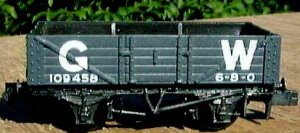
7 PLANK MINERAL - An RCH standard (1923) design, certainly used
by the GWR and LMS. Used in smaller numbers by the LNER, and the SR, both of
whom tended to favour 8 plank designs. Both 10 or 12 ton versions were
produced, the larger capacity wagon having heavier axles. From the early 1920's
the 12 tonner was the standard form (a 10 ton wagon occupied the same siding
space but earned less revenue than the 12 ton type). The earlier wagons were a
nine foot wheel base chassis, 16 foot 6 inches over headstocks (Peco now offer
a kit of this type on their nine foot wheelbase chassis, described above).
Seven plank mineral wagons were used by both the railway companies and private
owners, although end door types were more common on PO wagons. Adding an end
door is not difficult and this is described in the section on Kit Bashing. Some
7 plank general merchandise wagons were built by various companies. These can
be made up from this model by scribing and adding microstrip details to the
side doors and again this is described in the section on kit bashing. The examples shown have had their side doors modified to represent two pre-grouping designs (the stripe on the SECR wagon is supposed to represent an unpainted repair).

STEEL OPEN - A Butterly company patent design from 1935 large
numbers of which were leased or sold to private owners. These resemble a
riveted 15 ton wagon design built for the LNER in the 1930s but I have not yet
traced any illustrations of any similar wagons in service with other of the
pre-war Big Four companies. The Charringtons livery dates from the mid 30's and
was for a wagon operating out of London. BR would have taken many of these ex
PO wagons into its fleet, with a P prefix added to the number and this livery
is now available from Peco. In its guise of GWR loco coal wagon it should have
the end detail sand-papered off to represent plain sheeting and two vertical
stanchions added. The corners of this wagon were rounded so again some gentle
work with sandpaper or with the card type nail files is called for. The
diagonal stripes indicated which end the end-door was fitted and so should be
painted over. One other modification of possible interest is an early LNER
metal bodied general merchandise wagon. Sand off all the end detail to
represent plain sheeting, add two vertical supports at the ends, then cut away
the door section and make up a replacement wooden door (copy the Peco 5 plank).
I used scribed card with detail from microstrip and the result was acceptable.
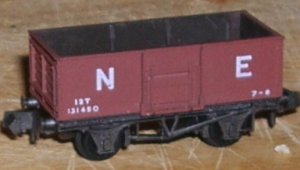
LIME WAGON - The lime wagon is typical of the type used by
various firms. The Peco model is the standard 5 plank open with a removable
roof unit incorporating the end planking. Two liveries are offered, Crawshay Bros (as shown below) and SLB. The latter was a firm also based in South Wales,
note that some of the SLB wagons did not have the fixed solid roof, some had
raised, curved ends and others had a fixed wooden beam between the peaked ends
to support a tarpaulin. Examples can be seen in the book 'The Tanat Valley
Light Railway' by Mike Lloyd, published by Wild Swan and both are easy
modifications to the standard Peco wagon. Some railway company 'departmental' 5
plank wagons were fitted with a similar peaked roof (possibly for ash
collection from outlying points on the system?) and there was an article in
Railway Modeller some years ago which showed a peak-roofed wagon used by the
army in WW1. Note that where the top doors became damaged, or leaked, it was
common practice to tie a tarpaulin over the top, this dodge was also used on
vans with damaged roofs. Some wagons of this general type had no top doors
(either damaged and removed or never fitted) and had a narrow strip of
tarpaulin tied across the central section of ther roof instead. The tarpaulin
dipped visibly where the door-hole was, so you would need to carve out a hole
in the roof section of the model leaving the central 'ridge' intact. Adding
full tarpaulins or tarpaulin 'doors' adds a little variety to a rake of wagons.
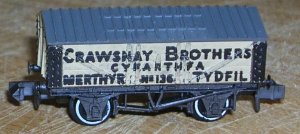
SALT WAGON - There is a photograph of the `Saxa' version of this
wagon, or one very much like it, in one of Bill Hudson's books on PO wagons,
they were used to move bagged domestic salt and so would be seen at most
locations at one time or another. Saxa was a brand name for Cerebos, now part
of British Salt Ltd, operating from Cheshire. It should be noted that there
were many and varied wagons used for salt and lime traffic, including hoppers,
ordinary opens, sheeted opens with or without raised curved ends and wooden or
patent hinged metal sheet rails, as well as peak roofed versions used by
private companies (don't forget the chemical companies, ICI for example) and
vans. The model is the standard open 7 plank wagon with an additional peaked
roof section which plugs into the top, similar to the lime wagon although with
slightly different roof detail.
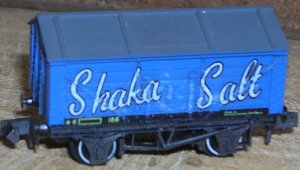
VENT VAN - A GWR `mink' standard design, also now
produced in BR colours. The planked doors date from 1927 and hence the large
letter GWR livery is legitimate. To produce the older outside framed doors
sand/scrape the planks away leaving the two centre planks and the two outermost
planks in place, then add horizontal framing top and bottom. The illustration below shows the RTR van and a kit which has been modified.
Fig ___ Old style doors for the Peco van

The large white spot on the Peco GW van marks this as a `Fruit B' which is specifically for
banana traffic, although the livery should really have the words `Banana Van'
in place of the word `Ventilated', and often a bunch of bananas in yellow above
this. Many of the banana vans also had a louvered vent between the uprights on
the end, this had a sliding cover, which makes cheating easy, a simple piece of
scribed card to represent the closed cover is all that is required. To convert
this to a general purpose van it may be possible to scrape off the spot,
although you may need to do a bit of painting and weathering to hide the marks.
STANDARD VAN - This is the British Railways standard banana
van (the design published in 1949 is based on the LMS ten ton banana van) for
which the Peco chassis is appropriate. In it's SR livery it captures the
general look of the original, although this was a horizontally planked van with
unusual brake gear. A simple modification to the doors prodices a handy NER van.
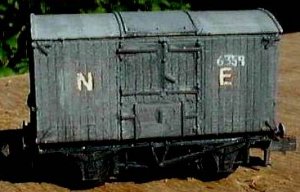
The body has vertically planked sides but horizontally planked ends and the model lends itself well to a number of conversions, both of vans and also of open wagons.
Fig___ Conversion based on the Peco van
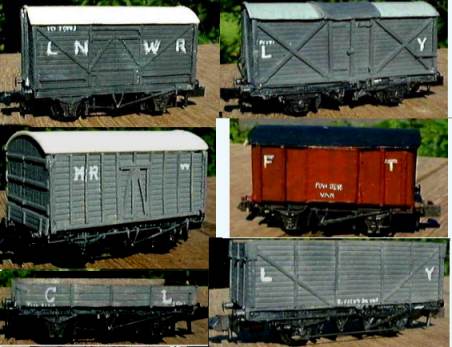
CATTLE WAGON - A BR standard type, based on a GWR standard design
(the GWR version, coded `Mex' and introduced pre 1923, had slightly different
upper doors).
Fig___ Peco cattle wagon converted to GWR type
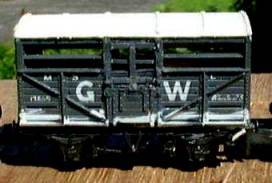
BR built cattle wagons to a mix of LMS, GWR and SR designs, but
the BR standard cattle wagon was closely based on the GW design. The last
cattle wagons were built in 1954 and were in service into the late 1960's/early
70's, mainly used for traffic to seaports for Ireland and the Scottish islands.
The last cattle trains moved on BR ran in 1975 but the business had been
winding down for many years at this time. The GWR and BR converted some of
these wagons to fruit vans, for details of which see the Kit Bashing section.
One sometimes sees pictures of pre-grouping cattle wagons with white interiors and white stains on their sides caused by `lime washing' the insides of the wagons as a way of disinfecting them. The interior of these wagons should be all white and the liquid leaked out between the planks as well as through the built-in openings. There would be patches of white all over the body but mainly where there were gaps such as the openings at the bottom and around the open upper sides. This practice was banned in the 1920's, so the stains should not appear on Big Four or British Railways stock, including the Peco wagon as supplied.
4 WHEEL TANK (10 foot wheelbase) - A standard design for an
un-lagged class `B' tank wagon. It is fitted with a stub for a bottom discharge
valve (the taller of the two stubs on top of the body) and so can not be used
for the carriage of highly flammable (Class A) liquids. Bottom discharge was
prohibited on class A tanks following incidents of leaking valves. To convert
this to a `Class A' tank remove the taller of the stubs on top of the tank.
Note that no `tap' or handle was carried on the discharge stub, this was to
prevent tampering in transit, the stub had a square section top to which a
valve handle was fitted at the discharge point. I have seen photographs of this
type of tank carrying oil in the 1950's but I have no definite date of
introduction. I believe it to be about 1938 for this particular design of tank,
which lacks the wire rope strop securing of earlier RCH standard designs. The
1902 specification for `class A' very flammable liquids and Class B heavy oils
and less volatile liquids is described in the livery section and from this it
would appear that the Peco Esso (class A) & BP (class B) tanks are in post
war livery.
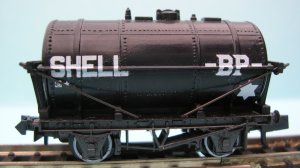
This tank is also available in United Daries and Express Daries milk tank livery, for which it is suitable for the very early 1930s, I believe the four wheelers were phased out in 1937.
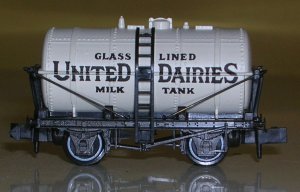
Models on the 15 foot wheel base chassis.
PLATE WAGON/DOUBLE BOLSTER- This design was originally LNER
dating from 1942/43, some sources quote 1937 but this was for the riveted type.
The two types were basically identical however and the riveting was not
especially noticeable so you can use it for a late 1930s layout. This wagon
design was apparently a joint venture with the LMS who produced wagons to a
near identical design from 1944 to 1949. The model captures the look of the
prototype rather well but the chassis is from the oil tank wagon and incorrect
for the plate type. You can produce an improved although still not quite
accurate chassis for the plate wagon using the triangular swinging link hangers
cut away and repositioned centrally as V hangers, with brake handles and push rods from 10x20 thou
strip and tie-bars from 10 thou brass wire. The sketch below shows the Peco chassis and the prototype plate wagon chassis
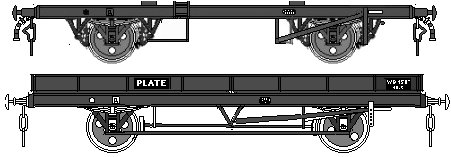
This type of plate wagon was adopted by BR as their standard design
(TOPS code SPV), they were eventually replaced in the 1980s by the air braked SPA (later
coded SAA) wagons introduced in 1977. Intended for the carriage of sheet metal,
usually steel plates, these wagons were also used to move cars and agricultural
machinery as the drop sides meant they could be easily loaded from a loading
bank. There is a photograph in Dave Larkin's book BR Standard Freight Wagons
published by D Bradford Barton in the 1970's which shows two Mini cars roped
onto such a wagon. The double bolsters were phased out in the 1970's, most had
the bolsters removed to become plate wagons, if buying kits however get the
bolster version as you can use the bolsters for converting other wagons to
bolster types. Redundant plate wagons were used as the basis of a wide range of
conversions, notably the trestle wagon, Conflat P wagons (for which use a
chassis kit as these had no 'body' as such) and Timber P wagons.
5 PLANK TUBE - A BR `ferry wagon' dating from 1950's, used on the
train ferry traffic to the continent, hence basically a Southern Region of BR
design. Again the underframe is for the forty five ton GLW tank wagon and the
wagon is therefore rather too short, but generally correct in outline.
8 PLANK TARPAULIN WAGON - Another ferry wagon, dating from 1957.
Only 40 of these 21 ton payload wagons were built, originally vac fitted with a
through air pipe all were changed to dual fitted, coded OJX and in the late
1980s they had the vacuum gear removed to be re-coded OJA. Ferry use of these
wagons ended in about 1975 and in the late 1980's they were in use as coke
wagons in Southern Region, carrying agricultural lime in Scotland and as
barrier wagons on Western Region. The tarpaulin rails were removed from most of
these wagons by the mid 1960's and by the early 1980's none remained in place.
I believe at least some of those on Western region had the body cut down to 5
planks. As supplied this wagon uses the tank wagon chassis, which is not quite
correct, the original having a 14 foot wheel base and different brake gear.
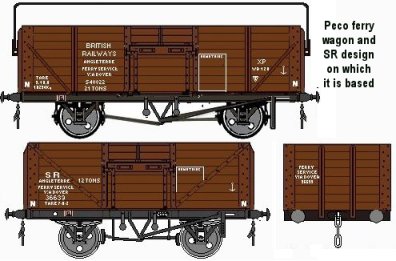
The
design of the body was based on a pre-grouping LSWR design adopted by the Southern Railway (who used it both for ferry work and for general goods traffic) and the Peco
body can be cut-down and fitted to a Peco ten foot wheelbase chassis to produce
a model of the type. This conversion is discussed in the section on 'Kit
Bashing', these shorter ex SR wagons survived into the 1970's. The model shown below is simply a cut down Peco kit and retains the Peco livery.
Fig___ Shortened Peco tarpaulin wagon
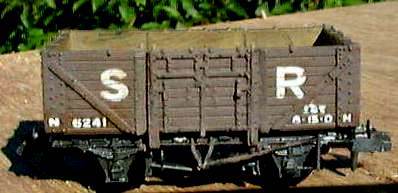
GRANO HOPPER - Introduced in 1965 for PO grain traffic. One of
the first of the `leased wagon' designs, built by BR and leased by BRT for hire to private owners, several batches were built, the last in 1971. BRT was a wagon
leasing company formed in 1902 and taken over by Procor in 1974 (Procor then
became Bombardier in the 1990's). The gain wagons were originally all painted in a basic
livery of blue, of those leased to Scottish Distillers some were fitted with a
large board on the side carrying advertisements for the leasing company. The
Distillers group, who used these wagons, subsequently leased some French
designed air braked bogie 'polybulk' wagons, making many of the four wheelers
redundant. In 1983 some of the redundant wagons were revamped by Procor with
new springs and air brakes, these were leased to TSL who painted them in the
green and grey livery of the TSL operated `Grainflow' fleet. Called `Minibulk'
(TOPS code PAA) the re-vamped grain wagons continued in this service until the
end of Speedlink in 1991, they are still in existence and may yet be re-used
for other traffic. Lima offered the bogie Polybulk wagon in the Granflo livery
in their OO range, which can be cribbed for a re-paint. Note Procor replaced
BRT on the small plate in the later 1970's, although not all such wagons had
that detail changed initially.
Fig ___ Original and Grainflow livery for Peco Grano Wagon
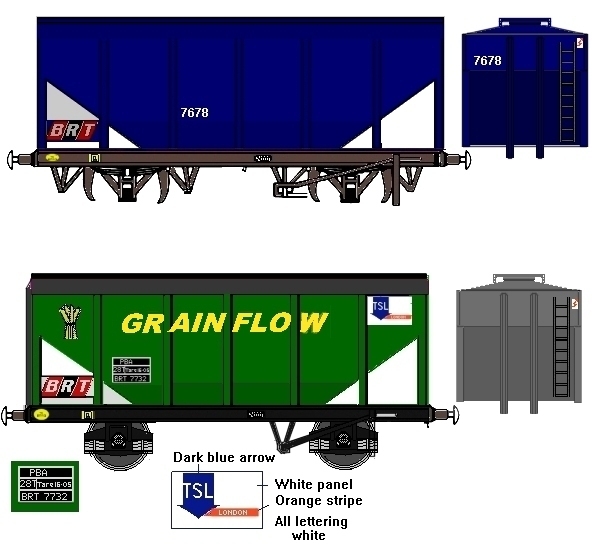
I believe that one other use for redundant grano wagons was carrying
bauxite from ships docked at Blyth near Newcastle to Fort William in Scotland
in the early 1980's for use in the manufacture of aluminium. The wagons were in a plain bauxite livery when on these
duties. This traffic is now all delivered by sea direct to the factory, being off loaded from ships
at anchor into large 800 ton barges which are then emptied using a shore crane
equipped with a grab to transfer the ore to a conveyor belt.
The Peco model can be cut down to produce a fair representation of the LMS, GWR and early BR type of grain hopper although this does require a bit of surgery to obtain an accurate profile. Making these wagons is discussed in the section on Kit Bashing.
Dapol have now released an RTR model of the BR grain hopper which makes life a lot easier.
4 WHEEL TANK - A standard 45 ton GLW (Gross Loaded Weight) design
built by British Railways and outside contractors for private owners and dating
from 1963. Smaller 35 ton GLW tanks were introduced in the late
1950's, (see Fig ___) but only Esso showed much interest at first. The 45 ton type follwed an increase in permitted axle weight and the tank became so large they had to put the ladders at one end. With the
change in policy regarding oil shipments in block 'company trains' in 1962
these modern wagons become more common. Many of these wagons are leased to the
oil companies, notably Esso who these days avoid actual ownership of rolling
stock, partly because of the costs of changing from vacuum brakes to air brakes for new stock from 1966 and retro fitted to older stock in the early 1970s.
Company liveries on oil tank wagons were constrained by
the rules on Class A and Class B cargo and particularly in the case of Class B cargo were mainly confined to the company
logo at one or both ends of the tank barrel, where they would not be affected by spillage of the fuel. Tanks carrying Class
A liquids (highly flammable goods such as petrol) have grey or plain metal tanks and should
have their solebars painted red.
The photo shows the Peco model in the guise of a Class A (highly infamable liquid) tank, the model as supplied has the correct red solebar.
Fig ___ Peco tank wagon in Fina petrol livery

The logos were generally phased out
from about 1974 and I understand cleaning is now carried out much less
frequently, the bodies being either plain black or grey, and the tanks are
often stained and streaked from spillages during loading. The `hazchem' warning
panel towards the lower left provides a splash of colour on the more modern liveries.
Peco now offer alternative bodies for LPG (Liquid Petroleum Gas, i.e.
Butane & Propane) wagons, a cement `Presflo' type wagon and an Albright
& Wilson chemical tank. Albright & Wilson tanks in this livery are used
for, amongst other things, shipping phosphoric acid, the cargo being identified
by the hazard plate on the side of the wagon and also its name in lettering
about 4 or 6 inches high to the lower left of the body. Phosphoric acid is
widely used in soft drinks and might also be delivered by rail to sugar
refineries, fertiliser factories, soap and detergent makers and oil refineries,
these tanks often have heavy white staining due to spillages during loading.
The LPG tank and the acid tank should both have red solebars.
The photo shows the Peco model in the guise of a Liquid Petroleum Gas tank, the band along the side of the tank is officially orange, in practice they tended to fade to this yellowish colour as on the model. The discharge pipe under the wagon should (I believe) be removed for the LPG tanker as the discharge connections were under the side mounted sliding covers. The sliding cover and associated rails on the lower tank side are printed on, adding rails of 10 thou rod gives a little relief and helps capture 'weathering' in the right area. In the later 1960s or early 1970s Mobil hired some wagons from BRT for LPG traffic from their London refinery, these form the basis for the Peco offering. The Peco Mobil tank can be back-dated from its mid 1970s livery by covering the 'P' logo on the left hand end with the standard three box BRT logo. These tanks do not seem to have had the rather visible manholes of the original 1962 type.
Fig ___ Peco tank wagon in mid 1970s Mobil LPG livery
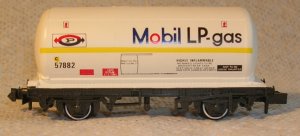
The gas tank model can be back-dated to represent one of the original 1962 Shell BP wagons, you should add a 3.5mm dia manhole on one end and a 2mm dia manhole on the other with two small stubs of 40 thou rod on the top centre of the roof at the end with the larger manhole. Adding the door (10 thou card 5mm x 4mm high with curved ends) with rails and handles from 10 thou strip is worth doing. In the later 1960s these lost the logos and were used by other companies, making painting easier. Esso and other firms later purchased or hired similar wagons for LPG traffic.
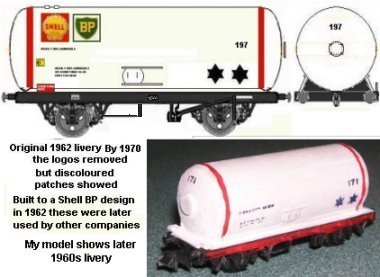
FISH/PARCELS VAN - This design was introduced by the LNER in the
latter part of the 1940's as a plywood bodied insulated fish van for use in
express passenger duties on the East Coast Main Line. BR built further examples
but all early models tended to suffer from overheating axle boxes, and all the
remaining vehicles were eventually fitted with roller bearings. As the fish
traffic transferred to road haulage some of these wagons transferred to parcels
duties when they were recoded SPV (Note this was not a TOPS code, it was the
abbreviation for Special Parcels Van). Peco offer both the blue Express Parcels
and white fish van liveries, however the fish van should have a blue disc,
about a foot in diameter, towards the left hand end of the body (these vans
were referred to as `blue spots' by enthusiasts). This livery is illustrated in the section on Livery BR 1948-1964 . The model runs on the standard Peco chassis, which is incorrect (the wheels should be a lot closer to the ends so the body is somewhat over long), however like many people I have a couple of these vans and can live with the compromise.
PALLET VAN - A 1960's BR design, 123 of these wagons were built
by British Railways. They were originally leased to Ford for the transportation
of spare parts. The model is very under length, the prototypes had a wheel base
of 20 foot 9 inches (as opposed to 15 foot as supplied), and a length over
headstocks of 35 foot (ten foot longer than the model), but it makes a pleasing
model for the modern image layout and the Ford livery at least is accurate. The
model is available in alternative liveries but I have not as yet traced any
definite references to these vehicles being used for traffic other than Fords. The basic kit can be used to produce a range of vehicles to fill in gaps in the available models, several of these are described in the section on Kit Bashing.
Models on special chassis.
46 Ton GLW HAA MGR Hopper
A useful model of a Merry-Go-Round 32.5 ton coal hopper and a new chassis specific to the type. These were originally coded HOP 32 AB, and introduced in 1964, over 10,000 being produced. The liveries at the time of writing are the pre 1974 TOPS 'HOP AB' (bauxite cradle), TOPS era 'HAA' BR Railfreight (red cradle, the 'sector era' coal sector markings (yellow cradle) and EWS Maroon. The HAA was developed for supplying regular customers such as power stations and it is fitted with automatic discharge gear. Top speed loaded is 45 mph and empty 50 mph. In the 1990s some of these wagons were revamped with improved suspension and air brakes to enable speeds of up to 60 mph and re-classified as HFA. Some routes have sufficient clearance to allow side and ends extensions to be fitted to the hopper to increase their capacity and Peco offer a pack of two such 'hoods' with loads to suit. In the early years a number of these wagons were built as covered hoppers with a solid roof with roof top hatches fitted and these remained in use, coded CBA, at least into the late 1990s carrying limestone. At the time of writing I am unaware of any RTR models or conversion kits for this variant. Some of the open wagons were also converted to carry china clay, re-coded CDA they entered service in January 1988. The CDA has a motorised canvass cover or 'hood' and Peco have released a model of this variant (discussed below)
CDA Hopper
Introduced in 1988 for china clay working these wagons are the standard HAA MGR hopper but fitted with a motorised retractable canvas 'roof', at the time of writing the Peco model is available in ECC Blue and EWS Maroon.
Brake vans
LNER (15' chassis) Basic design introduced 1929, unofficially
known as `Queen Mary' by the guards due to its size. The version supplied by
Peco has the running boards extended beyond the wheels, whereas on the LNER
version these were stopped just beyond the axle boxes. A single concrete bodied
version was tried, but although it lasted into BR days it was not considered a
success and no further examples were built.
BR (15' chassis) - The standard BR type, developed from a late
design of fitted van introduced by the LNER for their Green Arrow express goods
service. The full length foot boards are correct as supplied.
Fig___ Peco Brake Van kit as a BR fitted van
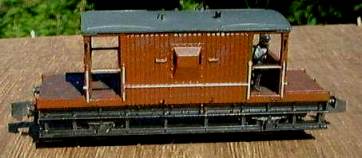
The example shown was picked up second hand, the builder had added the figure of the guard which is not supplied with the kit.
LNER (10' chassis) - This represents a 1934 `Toad E' van.
LMS (10' chassis) - A standard design, introduced pre 1923 by the
Midland Railway but the model has a 10 foot chassis, whereas the original ran
on a 12 foot wheelbase chassis, and so is a little short (the N Gauge Society
now offer a correct length model in the form of an etched brass kit).
MR (10' chassis) - A useful pre-grouping model for the LMS
modeller, available only in MR colours and not as far as I am aware in kit
form. Some of these may have survived into BR ownership but I doubt it.
There is also an SR brake van available as a kit, for details see the
section on available kits.
______________________________
^
Go to top of page



















